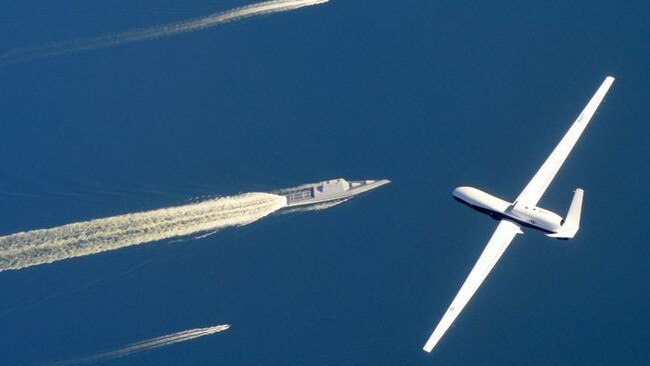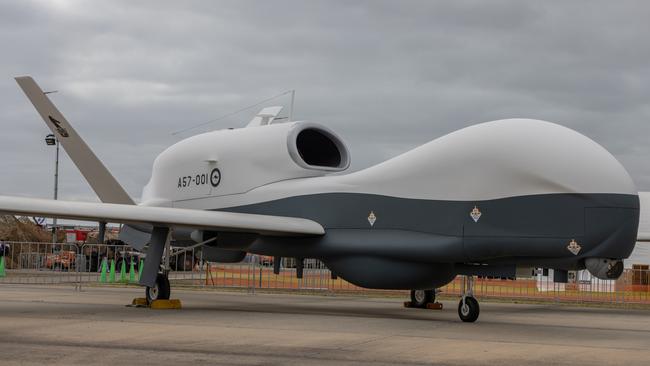Defence buys new $310m Triton drone despite capability doubts
Australia will purchase a fourth long-range Triton drone to patrol the country’s northern approaches as the US slashes its order for the unmanned aircraft.

Australia will purchase a fourth long-range Triton drone to patrol the country’s northern approaches as the US slashes its order for the unmanned aircraft that are deemed “not survivable” in high-threat environments.
Defence Industry Minister Pat Conroy will announce the investment on Tuesday along with a suite of upgrades to the RAAF’s P-8A Poseidon surveillance aircraft, including modifications to allow the planes to carry advanced anti-ship missiles.
The purchase of an additional MQ-4C Triton will add to the RAAF’s promised unmanned surveillance capabilities, allowing at least one to be in the air at all times.
But it comes as the first three Tritons are still yet to be delivered, and coincides with the Biden administration’s move to cut the US Navy’s Triton order from 70 to just 22.
The Poseidon upgrades from 2026 will enable the 14-strong fleet to carry Lockheed Martin’s Long-Range Anti-Ship Missiles, or LRASMs, which have a range of nearly 1000km. They will also get new long-range submarine detection technology, as well as increased communications bandwidth.
Mr Conroy said the combined $1.5bn worth of investments would ensure Australia had some of the world’s most advanced maritime surveillance and response capabilities.
“The purchase of an additional Triton will enhance operations from Australia’s northern bases – a priority under the Defence Strategic Review,” he said ahead of the announcement.
“The upgrades to the fleet of Poseidon aircraft strengthens our ability to secure and protect Australia’s maritime interests.”
The Northrop Grumman-made Tritons cost about $310m each, with the total approved program budget at about $2.5bn.

Strategic Analysis Australia’s research director Marcus Hellyer questioned the value of the program, which had been in the works for nearly two decades and cost taxpayers almost $1bn without a single aircraft delivered.
He said the US decision reflected the fact that they “are not survivable in the threat environments that will need to operate in”.
“The contested operating environments are now too dangerous for something like Triton, but other systems can perform surveillance in uncontested environments more affordably,” Dr Hellyer said.
“For example, some of the roles that Triton was to perform can now be done cheaply and reliably by commercial satellite constellations. So twenty years down the track, it’s not clear there’s a place for Triton – even before we’ve gotten anything out of it.”
The US decision to scale back its Triton fleet would drive up the sustainment costs for Australia’s four airframes, Dr Hellyer said, because through-life costs such as software and hardware upgrades would have to be shared over a smaller overall fleet.
The first of the Triton’s is about to enter testing in the US, and is due to be delivered by the middle of next year. The second and third are due six months later, and the fourth by mid-2025.
There is no word on whether Australia will get the six or seven Tritons that Defence had originally sought to enable persistent surveillance over the Pacific and the South China Sea.
The drones can fly for 24 hours at 50,000 feet, and have a range of 8200km. They will be networked with other ADF assets, including offensive strike systems.
When in service, the Triton aircraft will be based at RAAF Base Tindal, Northern Territory, and operated by the newly reformed Number 9 Squadron.
Upgrading the P-8s to carry LRASMs will transform the aircraft into potent long-range “missile trucks”, in addition to their maritime surveillance and anti-submarine warfare roles.
Australia has ordered 200 LRASMs for the RAAF’s F/A-18 Super Hornets, which are currently the only aircraft able to carry them.
But Lockheed Martin is working on integrating the missiles for use with P-8s – which will carry two under each wing – and will also configure them for use with F-35 stealth fighters.




To join the conversation, please log in. Don't have an account? Register
Join the conversation, you are commenting as Logout